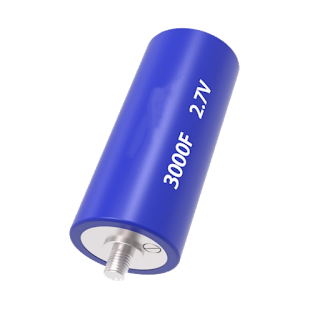Capacitors: Calculations & Simulations on Charging, Discharging Time & Voltage

Assume charging a completely discharged capacitor, under resistance, R with an applied potential, E having the capacitance, C.
Potential across the capacitor is Ec.
At time, t = 0s or to: EC < E; EC = 0 V.
If it is fully charged then EC = E and t = tc.
‘E’ is the maximum potential attained by the capacitor.
Time to reach maximum potential is: (tc – to).
At any given time, ‘t’ on charging in between to and tc the potential of the capacitor, EC is related to the maximum potential, E by the relation,
![]()
where ‘t’ is the elapsed time during charging
‘R’ is the resistance in Ω
‘C’ is the capacitance in F.
The product of R and C is called the time constant and is represented as, τ. So, τ = R × C.
Unit for τ
τ = R × C = Ω × {F} = Ω × {C × V–1}
C = Charge in Coulombs = A × s
= Ω × {A × s × V–1} = = Ω × {V × Ω–1 × s × V–1} = s.
At one time constant, capacitor is 63.2% charged.
In other words, if (t/τ)= 1, then EC = E × 0.632.
If, τ = 2s, the capacitor is 86.5% charged.
If, τ = 3s, the capacitor is 95% charged.
If, τ = 5s, the capacitor is 99.3% charged.
Time required, ‘t’ to reach EC, under the applied potential, E is given as:
![]()
In terms of current flow, it is given as:
![]()
Discharging
On discharging the relevant equations are:
![]()
But during discharging at (initial) time, t = 0 s, the potential across the capacitor is E (maximum starting potential).
Potential across the capacitor at any given time, ‘t’ during discharging is EC and EC < E, and EC decreases with time, t.
The time required, ‘t’ to discharge to the given potential, EC from E (initial potential) is given as:
![]()
In terms of current flow, it is given as:
![]()
Hence, 1 τ about 36.8 % is discharged from the initial potential, E.
At about 5 τ, the capacitor is almost discharged and the charge remaining will be about 0.7 % only.
Example
Estimate the time required for the fully discharged capacitor to charge 90 %. Also, estimate the charge at 5 minutes.

Formula:
![]()
‘t’ is the required time in seconds
‘E’ is applied potential or maximum potential = 60 V.
‘EC’ is the required potential of the capacitor to charge = 90 % of E.
EC = 0.9 × 60 V = 54 V
τ is one time constant; τ = R × C
R is 4000 Ω and Cap is 3000 × 10–3 F = 3 F
So one-time constant, τ = 4000 × 3 = 12000 s
Substituting these values, time required to charge 90 % (54 V) is 27631 s.
In the second part, EC is required at t = 5 minutes or after 300 seconds.
Required equation
is:
![]()
t = 300 s and τ = 12000 s, substituting these values, EC = 1.48 V.
To understand more about τ, check EC at τ.
One time constant, τ = 4000 × 3 = 12000 s.
So, EC at 12000 s, from the above equation:
EC = 37.93 V, in terms of percentage,
(EC/E) × 100 = (37.93/60) × 100 = 63.22%.
In terms of current flow, at one time constant value of IC is given as:
![]()
Current flow at time, t = 0 is given as:
![]()
With the increase in EC, current flow decreases, as R is constant (as per Ohm’s law: V = I × R).
Example
Estimate the time required for a fully charged capacitor at 30 V with 600 mF capacitance to discharge 30 % of its charge at a load of 3000 Ω. Also, estimate the percentage of charge left after 10 minutes of discharge.
Required equation is:
![]()
where E = 30 V (at t = 0): EC = (100 – 30) = 70 % remaining.
So, EC = 30 × 0.7 = 21 V.
τ = R × Cap = 3000 Ω × 600 × 10–3 F = 1800 s.
Hence, one time constant is 1800 s. Substituting these values, then t = 642 s.
So, at 642 s, the capacitor is discharged from 30 V to 21 V at 3000 Ω.
In terms of time constant, 642/1800 = 0.36 τ it is discharged to 30 %.
In the second
part, required equation is:
![]()
E = 30 V; t = 10 min. = 600 s and τ = 1800 s (one-time constant).
Substituting these values into the equation then, EC = 21.5 V.
In terms of percentage, (21.5/30) × 100 = 71.7 % charge is remaining.
So, after 600 s, (100 – 71.7) = 28.3 % or (30 – 21.5) = 8.5 V is discharged.
This is explained through circuit simulations in the following videos.
Part I
Part II
Part III

